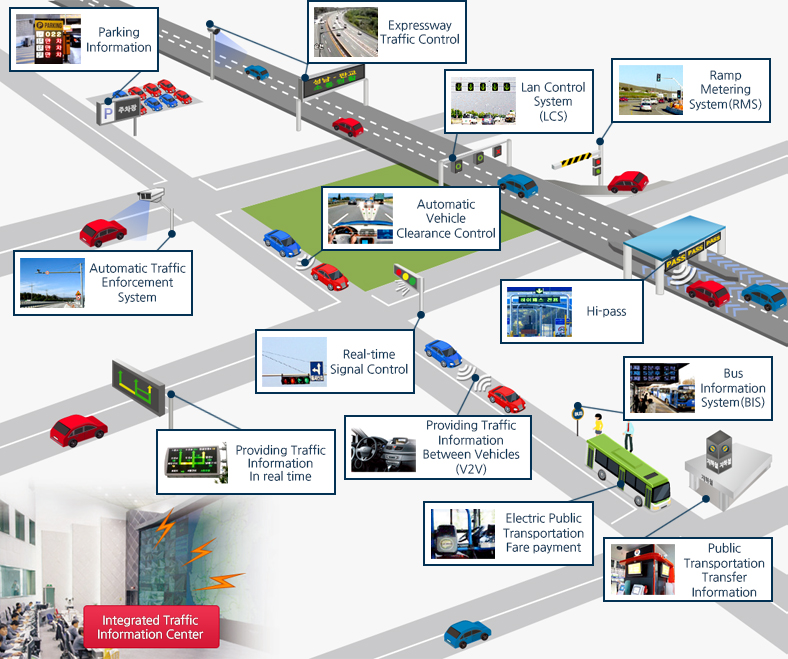ITS DEFINITION / INTRODUCTION EFFECT Introduces ITS
ITS Definition / Introduction effect
ITS definition
What is ITS (Intelligent Transport System)?
National Transport System Efficiency Act, Article 2 (Definition)
The term "intelligent transport system" refers to any transport system enabling the scientific and automated operation and management
of the transport system as well as the improvement of the efficiency and safety of transport by developing and utilizing the means of transport
and transport facilities with high-tech transport technology and transport information including electronic controls, communications, etc.

Definition of the ITS (Intelligent Transport System)
Korea (land area 99,720㎢, population 49,410,000) has a serious traffic problem due to 23,840,000 people living in the greater Seoul area (Source: Korea National Statistical Office, 2010). The cost of traffic congestion all over the country has exceeded 26 trillion won in 2008, with half of this caused by the increased spread of passenger cars (Source: Korea Transport Institute, 2011). The supply of transportation facilities falls short of demand due to limited financial resources and land, and the number of vehicle registrations is expected to reach 20 million by 2015 (18,440,000 cars registered in 2011), which will worsen traffic congestion all the more. In the face of such an increase in traffic congestion, we cannot think of transportation as a separate part of our daily lives.
We all want to move around safely and more conveniently. Our transportation system is evolving in such a way that user safety and convenience can be achieved with maximized efficiency in operation and use by integrating with state-of-the-art technology that is being developed day by day. It is with this background that the ITS was born.
What is ITS?
Intelligent Transport System(hereafter “ITS”) refers to any transport system enabling the scientific and automated operation and management of the transport system as well as the improvement of the efficiency and safety of transport by developing and utilizing the means of transport and transport facilities with high-tech transport technology and transport information including electronic controls, communications, etc. The ITS we find in our everyday life includes the bus arrival information system at the bus stop, the automatic intersection traffic signal system which changes according to the volume of traffic, real-time traffic information on navigation devices, and the Hi-pass service.
Introduction effects of the ITS
Now, we can avoid traffic congestion
You can travel by the fastest route with the help of real-time information on traffic conditions and bypass routes. You don’t have to stop at the toll gate to pay tolls. Signals change in real time according to road conditions. You can drive more comfortably with reduced waiting time at intersections.
Meeting the demands of low-carbon green growth
Most of the ITS technology is oriented toward low energy consumption and low carbon emissions. Other advanced countries like the U.S., Japan, and the U.K. are implementing a low-carbon green growth strategy at the national level. Korea is also making efforts to reduce CO2 emissions on the road by creating a green environment (U-Eco) and setting up green growth policies. The diffusion of the ITS will make a better global environment by switching to an IT-based low-carbon society.